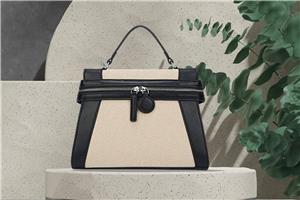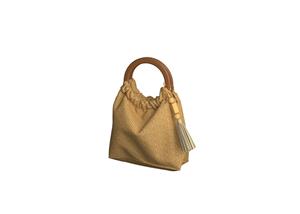Die 10 besten Materialien für Strohs?cke
Nachteile
Wasserempfindlichkeit: Maisschalen k?nnen schw?cher werden, wenn sie Feuchtigkeit ausgesetzt werden.Wartung: Um das Aussehen der Tasche zu erhalten, ist regelm??ige Pflege erforderlich.
Begrenzte Farboptionen
: Maisschalen gibt es meist in Naturt?nen.
9. Papierstrohhalm
überblick
Beschreibung und Herkunft
Papierstroh besteht aus dicht gewebten Papierfasern. Hersteller verarbeiten diese Fasern zu einem
langlebiges und flexibles Material
. Diese umweltfreundliche Alternative zu herk?mmlichen Materialien wie Leder oder Kunststoff hat in den letzten Jahren an Popularit?t gewonnen. Der Produktionsprozess beinhaltet Recyclingpapier, was es zu einer nachhaltigen Wahl für umweltbewusste Verbraucher macht.
H?ufige Verwendung in Strohs?ckenPapierstroh kommt h?ufig in Tragetaschen, Strandtaschen und Clutches vor. Kunsthandwerker verweben die Papierfasern zu komplizierten Mustern und schaffen so einzigartige Texturen und Designs. Viele Designer sch?tzen die Vielseitigkeit und Erschwinglichkeit von Papierstrohhalm. Hochwertige Modemarken und lokale Kunsthandwerker integrieren Papierstroh in ihre Kollektionen.
Vor-und NachteileVorteile
Umweltfreundlich: Papierstroh ist biologisch abbaubar, recycelbar und erneuerbar.
Haltbarkeit: Dicht gewebte Papierfasern bieten Festigkeit und Widerstandsf?higkeit.
Leicht
: Papierstrohbeutel sind leicht zu tragen und zu verpacken.Vielseitigkeit
: Das Material kann in verschiedenen Formen und Stilen gewebt werden.Bezahlbarkeit
: Papierstroh bietet eine kostengünstige Alternative zu anderen Materialien.Einfache Wartung
: Die Reinigung und Pflege von Papierstrohbeuteln ist einfach.
Nachteile
Wasserempfindlichkeit
: Papierstroh kann schw?cher werden, wenn es Feuchtigkeit ausgesetzt wird.
Begrenzte Farboptionen
: Natürliches Papierstroh gibt es normalerweise in neutralen T?nen.M?glicher Verschlei?: Im Laufe der Zeit k?nnen die Fasern Abnutzungserscheinungen aufweisen.10.Synthetisches Strohüberblick
Beschreibung und Herkunft
Synthetisches Stroh, auch Kunststroh genannt, ist ein künstliches Material, das das Aussehen und die Textur von natürlichem Stroh nachahmen soll. Hersteller stellen synthetisches Stroh aus verschiedenen Kunststoffen her, darunter Polypropylen und Polyethylen. Diese Materialien werden einem Extrusions- und Webprozess unterzogen, um haltbare und flexible Fasern zu bilden. Synthetisches Stroh bietet eine vielseitige und kostengünstige Alternative zu natürlichen Materialien.
H?ufige Verwendung in Strohs?ckenSynthetisches Stroh kommt h?ufig in Tragetaschen, Strandtaschen und Clutches zum Einsatz. Designer bevorzugen synthetisches Stroh wegen seiner F?higkeit, lebendige Farben und komplizierte Muster aufzunehmen. High-End-Modemarken und lokale Kunsthandwerker integrieren synthetisches Stroh aufgrund seiner Haltbarkeit und ?sthetik in ihre Kollektionen. Die Feuchtigkeitsbest?ndigkeit des Materials macht es ideal für Taschen, die für den Au?enbereich bestimmt sind.
Vor-und NachteileVorteile
Haltbarkeit: Synthetisches Stroh h?lt der t?glichen Beanspruchung stand, ohne seine Form oder Farbe zu verlieren.
Wasserbest?ndigkeit: Im Gegensatz zu natürlichem Stroh bleibt synthetisches Stroh unempfindlich gegenüber Feuchtigkeit und ist daher für verschiedene Wetterbedingungen geeignet.
Vielseitigkeit
: Das Material kann in einer Vielzahl von Farben gef?rbt und zu komplexen Mustern gewebt werden.Geringer Wartungsaufwand
: Synthetische Strohs?cke erfordern nur minimale Pflege, um ihr Aussehen zu bewahren.Bezahlbarkeit
: Synthetisches Stroh bietet im Vergleich zu natürlichen Materialien eine preisgünstige Option.Nachteile
Umweltbelastung
: Synthetisches Stroh ist nicht biologisch abbaubar und tr?gt zur Plastikverschmutzung bei.
?sthetische Einschr?nkungen
: Einige Verbraucher bevorzugen m?glicherweise das natürliche Aussehen und die Haptik traditioneller Strohmaterialien.
Hitzeempfindlichkeit
: Hohe Temperaturen k?nnen dazu führen, dass sich synthetisches Stroh verzieht oder schmilzt, was den Einsatz unter extremen Bedingungen einschr?nkt.
Produktinformation
:
Bolsa de paja de plástico: Fabricado con materiales reciclados, ofrece una forma moldeable y cómodas asas con cinturón.
Bolsas de papel con asa de paja: Sostenible y ecológico, brindando durabilidad y versatilidad para diversos dise?os.
La paja sintética ofrece unaalternativa práctica y elegante
a materiales de paja natural. Sus ventajas en cuanto a durabilidad, resistencia al agua y versatilidad lo convierten en una opción popular para muchos consumidores. Sin embargo, se deben considerar el impacto ambiental y las limitaciones estéticas al seleccionar un material para las bolsas de paja.Elegir el material adecuado para las bolsas de paja garantiza durabilidad y estilo. Cada material ofrece beneficios únicos:
Paja Natural
: Ecológico y ligero.Rafia
: Durable y versátil.pastos marinos
: Flexible y rústico.jacinto de agua
: Sostenible y encantador.
Yute
: Robusto y natural.
Bambú
: Fuerte y elegante.
Hojas de palma
: Versátil y hermosa.
Hoja de maíz
: Ecológico y único.Paja de papel
: Asequible y reciclable.Paja Sintética
: Langlebig und wasserbest?ndig.Berücksichtigen Sie bei der Materialauswahl pers?nliche Bedürfnisse und Vorlieben. Entdecken Sie verschiedene Optionen, um den perfekten Strohsack zu finden.
Lightweight: Water hyacinth bags are easy to carry and pack.
Disadvantages
Water Sensitivity: Water hyacinth can weaken when exposed to moisture.
Maintenance: Regular care is needed to maintain the bag's appearance.
Limited Color Options: Water hyacinth usually comes in earthy tones.
5.Jute
Overview
Description and origin
Jute comes from the stem and outer skin of the jute plant, primarily grown in India and Bangladesh. Farmers harvest the plants, soak them in water, and then strip the fibers. These fibers are long, soft, and shiny, making them ideal for weaving.
Common uses in straw bags
Jute often appears in tote bags, beach bags, and market bags. Artisans weave jute fibers into sturdy and durable patterns. Many designers appreciate jute for its rustic charm and eco-friendly nature.
Pros and Cons
Advantages
Eco-Friendly: Jute is biodegradable and sustainable.
Durability: Properly treated jute can withstand daily use.
Aesthetic Appeal: The natural texture and color offer a unique look.
Lightweight: Jute bags are easy to carry and pack.
Disadvantages
Water Sensitivity: Jute can weaken when exposed to moisture.
Maintenance: Regular care is needed to maintain the bag's appearance.
Limited Color Options: Jute usually comes in earthy tones.
6.Bamboo
Overview
Description and origin
Bamboo is a fast-growing grass found in various parts of the world, including Asia, Africa, and South America. Harvesters cut the bamboo stalks and then process them into thin strips. These strips undergo treatment to enhance their flexibility and durability. Bamboo's natural strength and unique texture make it an excellent material for crafting bags.
Common uses in straw bags
Bamboo often appears in tote bags, beach bags, and clutches. Artisans weave bamboo strips into intricate patterns, creating visually appealing designs. High-end fashion brands incorporate bamboo into their collections for its eco-friendly properties and aesthetic appeal. Bamboo bags are popular for both casual outings and formal events.
Pros and Cons
Advantages
Eco-Friendly: Bamboo is a sustainable and biodegradable material.
Durability: Bamboo fibers are strong and can withstand daily use.
Aesthetic Appeal: The natural texture and color offer a unique and elegant look.
Lightweight: Bamboo bags are easy to carry and pack.
Versatility: Bamboo can be woven into various shapes and styles.
Disadvantages
Water Sensitivity: Bamboo can weaken when exposed to moisture.
Maintenance: Regular care is needed to maintain the bag's appearance.
Limited Color Options: Bamboo usually comes in natural tones.
7.Palm Leaves
Overview
Description and origin
Palm leaves come from various species of palm trees found in tropical regions. Harvesters collect the leaves and dry them to create flexible fibers. These fibers have been used for centuries in traditional crafts and weaving.
Common uses in straw bags
Palm leaves are often used in beach bags, tote bags, and clutches. Artisans weave the leaves into intricate patterns, creating unique textures and designs. Many designers appreciate the natural beauty and versatility of palm leaves.
Pros and Cons
Advantages
Eco-Friendly: Palm leaves are biodegradable and sustainable.
Durability: Properly treated palm leaves can withstand daily use.
Aesthetic Appeal: The natural texture and color offer a unique look.
Lightweight: Palm leaf bags are easy to carry and pack.
Disadvantages
Water Sensitivity: Palm leaves can weaken when exposed to moisture.
Maintenance: Regular care is needed to maintain the bag's appearance.
Limited Color Options: Palm leaves usually come in natural tones.
8.Corn Husk
Overview
Description and origin
Corn husk comes from the outer covering of corn ears. Farmers collect these husks after harvesting the corn. The process involves drying and preparing the husks for weaving. This material has been used traditionally in various cultures for crafting and decoration.
Common uses in straw bags
Corn husk often appears in tote bags, beach bags, and clutches. Artisans weave the husks into intricate patterns, creating unique textures. Many designers appreciate corn husk for its eco-friendly properties and rustic charm.
Pros and Cons
Advantages
Eco-Friendly: Corn husk is biodegradable and sustainable.
Durability: Properly treated corn husk can withstand daily use.
Aesthetic Appeal: The natural texture and color offer a unique look.
Lightweight: Corn husk bags are easy to carry and pack.
Versatility: Corn husk can be woven into various shapes and styles.
Disadvantages
Water Sensitivity: Corn husk can weaken when exposed to moisture.
Maintenance: Regular care is needed to maintain the bag's appearance.
Limited Color Options: Corn husk usually comes in natural tones.
9.Paper Straw
Overview
Description and origin
Paper straw comes from tightly woven paper fibers. Manufacturers process these fibers to create a durable and flexible material. This eco-friendly alternative to traditional materials like leather or plastic has gained popularity in recent years. The production process involves recycling paper, making it a sustainable choice for environmentally conscious consumers.
Common uses in straw bags
Paper straw often appears in tote bags, beach bags, and clutches. Artisans weave the paper fibers into intricate patterns, creating unique textures and designs. Many designers appreciate the versatility and affordability of paper straw. High-end fashion brands and local artisans alike incorporate paper straw into their collections.
Pros and Cons
Advantages
Eco-Friendly: Paper straw is biodegradable, recyclable, and renewable.
Durability: Tightly woven paper fibers offer strength and resilience.
Lightweight: Paper straw bags are easy to carry and pack.
Versatility: The material can be woven into various shapes and styles.
Affordability: Paper straw provides a cost-effective alternative to other materials.
Easy Maintenance: Cleaning and maintaining paper straw bags is simple.
Disadvantages
Water Sensitivity: Paper straw can weaken when exposed to moisture.
Limited Color Options: Natural paper straw usually comes in neutral tones.
Potential Wear and Tear: Over time, the fibers may show signs of wear.
10.Synthetic Straw
Overview
Description and origin
Synthetic straw, also known as faux straw, is a man-made material designed to mimic the appearance and texture of natural straw. Manufacturers create synthetic straw using various plastics, including polypropylene and polyethylene. These materials undergo a process of extrusion and weaving to form durable and flexible fibers. Synthetic straw offers a versatile and cost-effective alternative to natural materials.
Common uses in straw bags
Synthetic straw often appears in tote bags, beach bags, and clutches. Designers favor synthetic straw for its ability to hold vibrant colors and intricate patterns. High-end fashion brands and local artisans incorporate synthetic straw into their collections for its durability and aesthetic appeal. The material's resistance to moisture makes it ideal for bags intended for outdoor use.
Pros and Cons
Advantages
Durability: Synthetic straw can withstand daily wear and tear without losing its shape or color.
Water Resistance: Unlike natural straw, synthetic straw remains unaffected by moisture, making it suitable for various weather conditions.
Versatility: The material can be dyed in a wide range of colors and woven into complex patterns.
Low Maintenance: Synthetic straw bags require minimal care to maintain their appearance.
Affordability: Synthetic straw provides a budget-friendly option compared to natural materials.
Disadvantages
Environmental Impact: Synthetic straw is not biodegradable and contributes to plastic pollution.
Aesthetic Limitations: Some consumers may prefer the natural look and feel of traditional straw materials.
Heat Sensitivity: High temperatures can cause synthetic straw to warp or melt, limiting its use in extreme conditions.
Product Information:
Plastic Straw Bag: Made from recycled materials, offering a moldable shape and comfortable belted handles.
Paper Straw Handle Bags: Sustainable and eco-friendly, providing durability and versatility for various designs.
Synthetic straw offers a practical and stylish alternative to natural straw materials. Its advantages in durability, water resistance, and versatility make it a popular choice for many consumers. However, the environmental impact and aesthetic limitations should be considered when selecting a material for straw bags.
Choosing the right material for straw bags ensures durability and style. Each material offers unique benefits:
Natural Straw: Eco-friendly and lightweight.
Raffia: Durable and versatile.
Seagrass: Flexible and rustic.
Water Hyacinth: Sustainable and charming.
Jute: Sturdy and natural.
Bamboo: Strong and elegant.
Palm Leaves: Versatile and beautiful.
Corn Husk: Eco-friendly and unique.
Paper Straw: Affordable and recyclable.
Synthetic Straw: Durable and water-resistant.
Consider personal needs and preferences when selecting a material. Explore different options to find the perfect straw bag.




